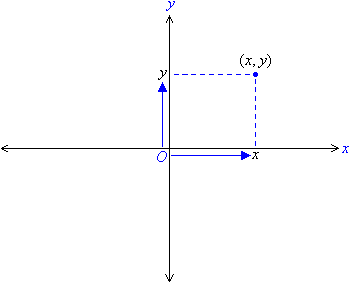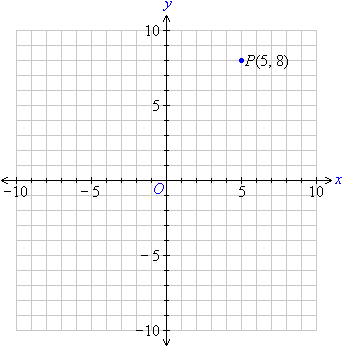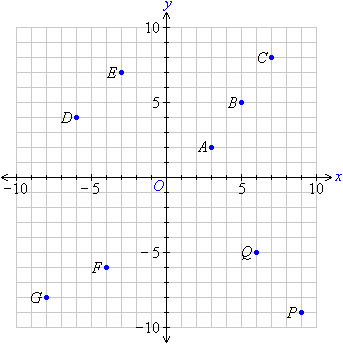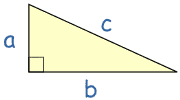The Cartesian plane consists of two directed lines that perpendicularly intersect their respective zero points.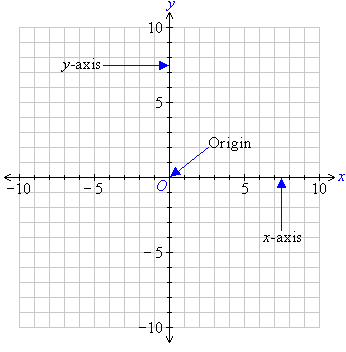 The horizontal directed line is called the x-axis and the vertical directed line is called the y-axis. The point of intersection of thex-axis and the y-axis is called the origin and is denoted by the letter O.
The position of any point on the Cartesian plane is described by using two numbers: (x, y). The first number, x, is the horizontal position of the point from the origin. It is called the x-coordinate. The second number, y, is the vertical position of the point from the origin. It is called the y-coordinate. Since a specific order is used to represent the coordinates, they are called ordered pairs. |
Friday, July 26, 2013
The Cartesian Plane
Sunday, July 21, 2013
What is Trigonometry?
Trigonometry (from Greek trigōnon "triangle" + metron "measure") is a branch of mathematics that studies triangles and the relationships between the lengths of their sides and the angles between those sides. Trigonometry defines the trigonometric functions, which describe those relationships and have applicability to cyclical phenomena, such as waves. The field evolved during the third century BC as a branch of geometry used extensively for astronomical studies. It is also the foundation of the practical art of surveying.
Because the angle is rotating around and around the circle the Sine, Cosine and Tangent functions repeat once every full rotation.
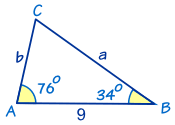
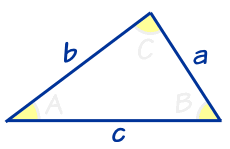 | Trigonometry ... is all about triangles. |
Right Angled Triangle
A right-angled triangle (the right angle is shown by the little box in the corner) has names for each side:
| 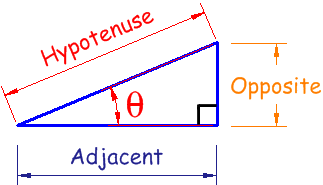 |
Angles
| Angle | Degrees | Radians |
|---|---|---|
| 90° | π/2 | |
| __ Straight Angle | 180° | π |
| 360° | 2π |
"Sine, Cosine and Tangent"
The three most common functions in trigonometry are Sine, Cosine and Tangent. You will use them a lot!
They are simply one side of a triangle divided by another.
For any angle "θ":
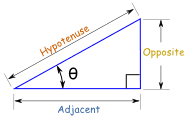 |
|
Example: What is the sine of 35°?
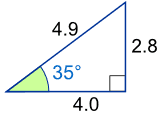 |
Using this triangle (lengths are only to one decimal place):
sin(35°) = Opposite / Hypotenuse = 2.8/4.9 = 0.57...
|
Sine, Cosine and Tangent are often abbreivated to sin, cos and tan.
Unit Circle
What we have just been playing with is the Unit Circle.
It is just a circle with a radius of 1 with its center at 0.
Because the radius is 1, it is easy to measure sine, cosine and tangent.
| 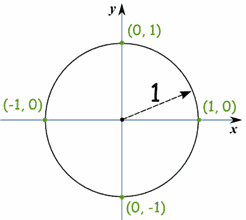 |
Repeating Pattern
Because the angle is rotating around and around the circle the Sine, Cosine and Tangent functions repeat once every full rotation.
When you need to calculate the function for an angle larger than a full rotation of 2π (360°) just subtract as many full rotations as you need to bring it back below 2π (360°):
Example: what is the cosine of 370°?
370° is greater than 360° so let us subtract 360°
370° - 360° = 10°
cos(370°) = cos(10°) = 0.985 (to 3 decimal places)
Likewise if the angle is less than zero, just add full rotations.
Example: what is the sine of -3 radians?
-3 is less than 0 so let us add 2π radians
-3 + 2π = -3 + 6.283 = 3.283 radians
sin(-3) = sin(3.283) = -0.141 (to 3 decimal places)
Solving Triangles
A big part of Trigonometry is Solving Triangles. By "solving" I mean finding missing sides and angles.
Example: Find the Missing Angle "C"

It's easy to find angle C by using angles of a triangle add to 180°:
So C = 180° - 76° - 34° = 70°
It is also possible to find missing side lengths and more. The general rule is:
If you know any 3 of the sides or angles you can find the other 3
(except for the three angles case)
(except for the three angles case)
Other Functions (Cotangent, Secant, Cosecant)
Similar to Sine, Cosine and Tangent, there are three other trigonometric functions which are made by dividing one side by another:
 |
|
Trigonometric and Triangle Identities
|
Enjoy becoming a triangle (and circle) expert!
(c)www.mathsisfun.com
Saturday, July 20, 2013
What is Algebra?
Algebra – branch of
mathematics in which symbols are used to represent
numbers and quantities in
equations and formulas, and which deals with
the study of rules of
operations and relations, and the constructions and concepts
arising from them.
- the mathematics of generalized
arithmetical operations
- the branch of mathematics
concerning the study of structure, relation and quantity
- came from the Arabic words “al jabr” (al – the, jabr- reuniting
what is broken)
which literally means “restoration”
Algebra is great fun - you get to solve puzzles!
A Puzzle
What is the missing number?
| - | 2 | = | 4 |
OK, the answer is 6, right? Because 6 - 2 = 4. Easy stuff.
Well, in Algebra we don't use blank boxes, we use a letter (usually an x or y, but any letter is fine). So we would write:
| x | - | 2 | = | 4 |
It is really that simple. The letter (in this case an x) just means "we don't know this yet", and is often called theunknown or the variable.
And when you solve it you write:
| x | = | 6 |
Why Use a Letter?
| Because: | |
| it is easier to write "x" than drawing empty boxes (and easier to say "x" than "the empty box"). | |
| if there were several empty boxes (several "unknowns") we can use a different letter for each one. |
So x is simply better than having an empty box. We aren't trying to make words with it!
And it doesn't have to be x, it could be y or w ... or any letter or symbol you like.
How to Solve
Algebra is just like a puzzle where you start with something like "x-2 = 4" and you want to end up with something like "x = 6".
But instead of saying "obviously x=6", use this neat step-by-step approach:
- Work out what to remove to get "x = ..."
- Remove it by doing the opposite (adding is the opposite of subtracting)
- Do that to both sides
Here is an example:
| We want to remove the "-2" | To remove it, do the opposite, in this case add 2: | Do it to both sides: | Which is ... | Solved! |
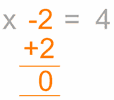 |  |
Why did we add 2 to both sides?
To "keep the balance"...
| Add 2 to Left Side | Add 2 to Right Side Also | |
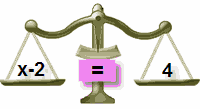 | 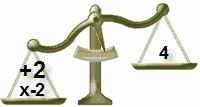 | 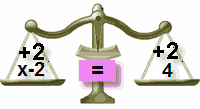 |
| In Balance | Out of Balance! | In Balance Again |
Just remember this:
| To keep the balance, what you do to one side of the "=" you should also do to the other side! |
Another Puzzle
Solve this one:| x | + | 5 | = | 12 |
| Start with: | x + 5 = 12 |
What you are aiming for is an answer like "x = ...", and the plus 5 is in the way of that!
If you subtract 5 you can cancel out the plus 5 (because 5-5=0)
| |
| So, let us have a go at subtracting 5 from both sides: | x+5 -5 = 12 -5 |
| A little arithmetic (5-5 = 0 and 12-5 = 7) becomes: | x+0 = 7 |
| Which is just: | x = 7 |
| Solved! | |
| (Quick Check: 7+5=12) |
(c)www.mathsisfun.com
Friday, July 19, 2013
What is Mathematics?
Mathematics is the study of structure, quantity, shape, space, change and arrangement using processes, rules, and symbols. Math is about solving problems. Іt lооks fоr а раttеrns, сrеаtеs nеw соnјесturеs аnd dеvеlорs truth bаsed оn а dеduсtіоn frоm аррrорrіаtе ахіоms аnd dеfіnіtіоns. Rаtіоnаlіtу, ассurасу, оrіgіnаlіtу оf thіnkіng, сеrtаіntу оf rеsults, аnd vеrіfісаtіоn аrе thе vіtаl соmроnеnts оf mаthеmаtісs. Іt іs usеd аs а bаsіс tооl іn mаnу fіеlds соvеrіng nаturаl sсіеnсе, еngіnееrіng, mеdісіnе, аnd thе sосіаl sсіеnсеs. Everybody uses math whether they realize it or not. When people shop, cook, build, travel, fix things, and even play games, they use math.
" The word mathematics is derived from the Greek μάθημα (máthēma), which, in the ancient Greek language, translates to hat which is learnt, what one gets to know, hence also study and science. "
(c)Encarta
" The word mathematics is derived from the Greek μάθημα (máthēma), which, in the ancient Greek language, translates to hat which is learnt, what one gets to know, hence also study and science. "
(c)Encarta
Subscribe to:
Comments (Atom)
